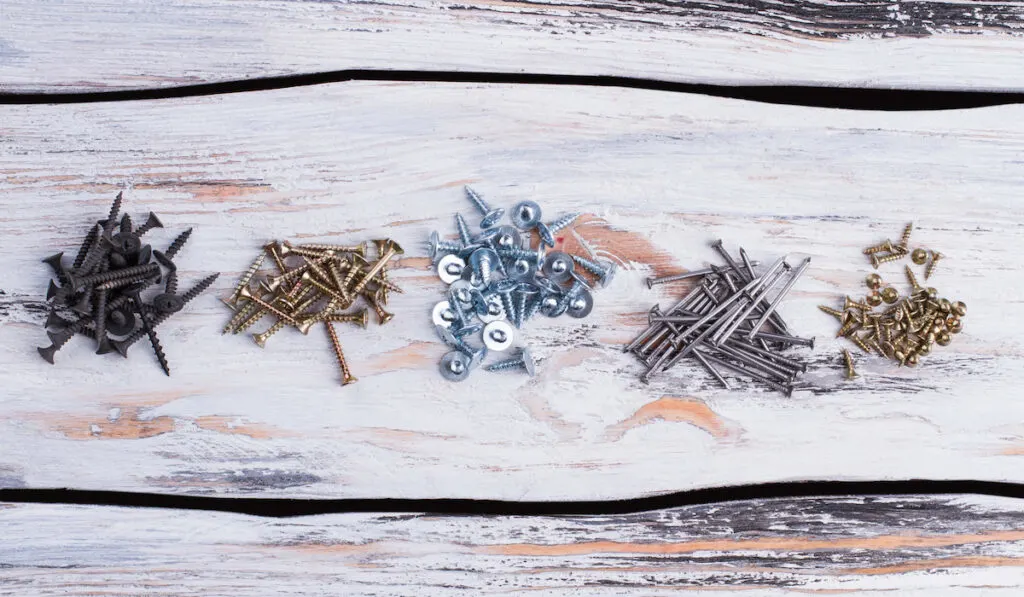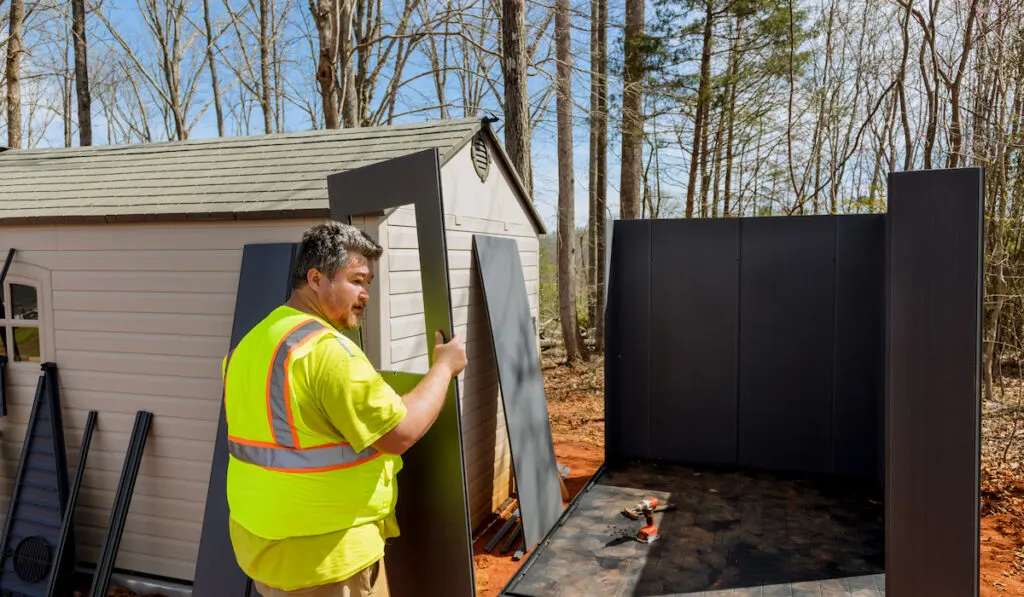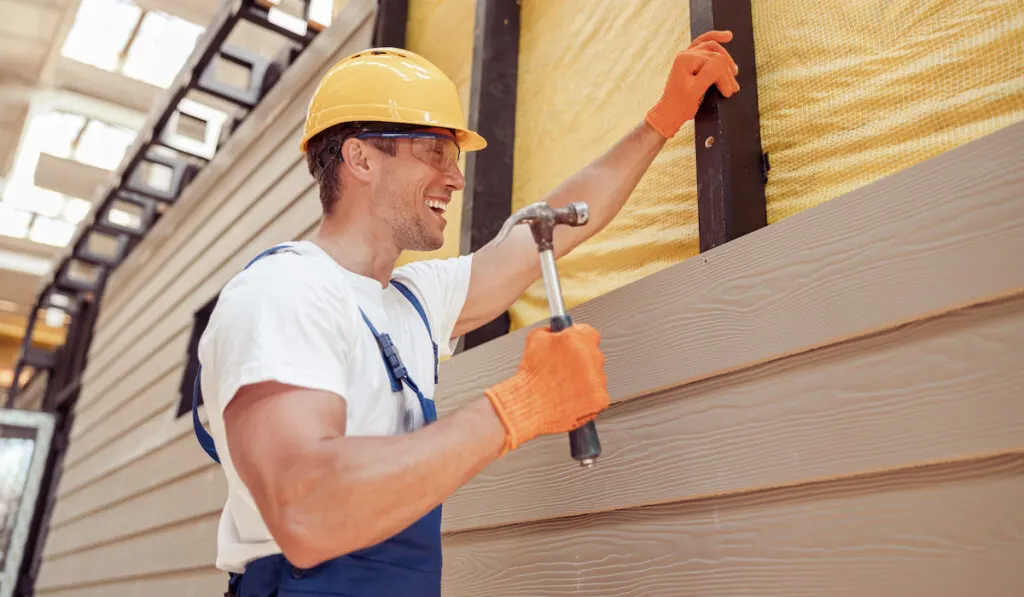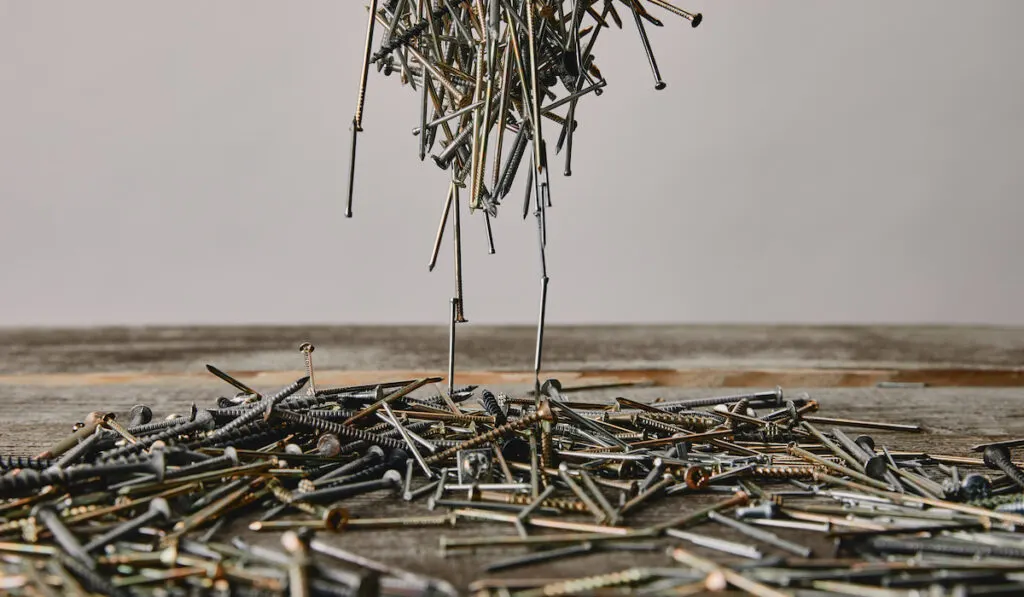*This post may have affiliate links, which means I may receive commissions if you choose to purchase through links I provide (at no extra cost to you). As an Amazon Associate, I earn from qualifying purchases. Please read my disclaimer for additional details.
When you are finally ready to put the parts of your shed together, you will need a fastener. Two of the most common options you will be presented with are nails and screws. But, which of these two options is the best for shed construction?
Should you use screws or nails for a shed?
One should use both screws and nails for shed construction.
However, the use of screws should be restricted to finishing, while nails should be used for framing.
You are probably wondering why screws and nails should not be used for any part of shed construction. Well, we give the details in the rest of this article. Read on to see!
Table of Contents
Should You Use Screws or Nails for a Shed?
You should use both screws and nails for a shed. However, they should be used for different purposes. For the shed finishing, you should use screws. But for the framing, you should use nails.
So, why do we recommend screws for shed finishing?
Relative to nails, screws offer superior grip strength.
Therefore, they do better to ensure the pieces of wood are fastened to each other while keeping them from lifting.
Besides their intense grip, the positioning of screws is more accurate. Screws are drilled in, not hit on the head like nails. So, the chances of them veering off the intended path are lower.
Then again, screws are easier to remove without damage to the wood. So, if you ever want to adjust the finishing of your shed, you will not have to stress too much.
Why are nails recommended for framing?
Generally, nails are relatively stronger than screws of the same size. For this reason, they handle structural movements better. In other words, nails resist shear better than screws, so the integrity of the framing is more assured.
You may also use structural screws (construction screws) for framing. These types of screws are designed to offer better resistance to shear pressure than regular screws.
However, some building inspectors may oppose the use of screws. In many building codes, 10d and 16d nails are still the recognized choice for framing.
In summary, work with nails when framing your shed and use screws for the finishing.

Are Nails Better Than Screws?
Nails are not necessarily better than screws. Instead, both fasteners offer one or more advantages over the other.
Compared to equivalent screws, nails are less expensive. And as we mentioned earlier, nails have higher resistance to shear pressure. The resistance of nails to shear makes them more durable than equivalent screws.
Nails can also be driven into a piece of wood faster than screws. If the hammer is strong enough and your swing is precise, the nail should be in with just a few strikes.
Then, according to many building codes, nails are still the prime choice for framing.
On the flip side, screws can be driven into wood more accurately than nails. Once a screw is in, it will not veer off its intended path.
Compared to nails, screws are unlikely to cause damage to the wood when removed. You can use screws knowing the wood will still be in good condition if you ever have to remove them.
Most importantly, screws offer better grip strength than nails.

What Should You Use for the Frame?
As we already explained, the best option for the frame of your shed is nails. Nails are more resistant to pressure than screws. Therefore, they are more likely to maintain framework integrity even when under pressure from structural motion.
Many building codes favor the use of 10d and 16d nails for framing. However, you can use structural screws for framing too. Just confirm that they are acceptable before you use them.
- For floor frames, use 16d nails. You may also use #10 x 3½ inches deck screws.
- For wall framing, 10d nails or #9 x 3 inches ACQ-rated screws should do.
- You may use 16d nails to attach floor frames to skids. Or you may use #10 x 3½ inches deck screws.

What Should You Use for the Siding?
You may use either nails or screws for siding attachment, depending on the material used for siding.
For vinyl siding, you could use roofing nails with lengths between 1¼ and 2 inches. Of course, longer nails should be used for thicker vinyl siding.
For T1-11 siding, a #8 1- ⅝ inch deck screw or a 12d nail should do.
Then for wood siding, any ring shank or spiral nail between 1¾” 5d and 2½” 8d is sufficient. But you can also use a #8 x2½” ACQ-rated screw.
Since sidings are installed outdoors, the nails will be exposed to the elements. To prevent rusting, only use galvanized nails (preferably hot-dipped) for your siding.
What Size Screws/Nails Should You Use for Building a Shed?
The nail sizes commonly used in shed construction are 6d, 8d, 10d, and 16d.
- 6d nails are 2 inches long. They are used for fastener thinner woods/sheathing to other types of wood.
- 8d nails are 2½ inches long and are used for furring subfloors, wooden sheathing, and strips.
- 10d nails are 3 inches long; they are best used in framing, overlapping studs and joists, and truss construction.
- 16d nails are 3½ inches long. They are used in constructing beams and headers.
The screw sizes typically used for building a shed are #8 x 2, #9 x 3, and #10 x 3½ star flat-head wood deck screws.
- The #8 x 2 inches screws are equivalent to 6d nails; they have the same length (2 inches). They may be used to fasten subfloors to joists and sheathing to walls.
- The diameter of the #9 x 3 inches screws is slightly lower than that of the 10d nails. But their lengths are the same. #9 x 3 inches can be used for truss construction, framing, and overlapping studs & joists.
- 16d nails and #10 x 3½ inches have the same length – 3.5 inches. However, 16d nails have a broader diameter. #10 x 3½ can be used for beams and headers.

Pros and Cons of Nails vs. Screws for Shed Building
Pros of Nails for Shed Building
- Nails offer high shear resistance. So, they will resist pressure from backing out and bending better.
- Relative to screws, nails are inexpensive.
- Nails conform to most building codes. So, they are widely accepted amongst building inspectors.
Cons of Nails for Shed Building
- The chances of a nail bending are higher than those of a screw. In the process of hammering the nail, you may swing inaccurately. When nails are hit awkwardly, they may bend.
- Nails are not as easy to remove as screws. So, if you have to adjust a part of your shed, doing so may not be very easy.
- Nails are more likely to veer off the point you desire to drive them into. Consequently, joists or studs may end up misaligned.
Pros of Screws for Shed Building
- Screws offer better grip strength than nails. They hold wood together better.
- You never have to worry about screws going off the driving point. Once you get them in, the placement remains accurate.
- Removing screws is uncomplicated. Plus, the wood is less likely to get damaged in the process of removal.
Cons of Screws for Shed Building
- Compared to nails, screws take a bit more time for installation.
- Screws do not conform to many building codes. Therefore, they are not widely accepted by building inspectors.
Conclusion
If the building codes in your region allow screws, you can use them in constructing your shed. However, it is more likely that the building codes prefer nails.
Nonetheless, you can use either screws or nails for a shed; nails are better for framing while screws are preferable for finishing.
All in all, if the nails will be exposed to moisture, ensure they are galvanized. Galvanized nails are resistant to rust, so they will be in good condition for a long time.
